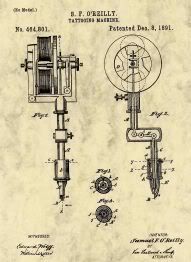History of the Tattoo Machine: How Thomas Edison, Samuel O'Reilly & Percy Waters Led the Way
 In 1891, the first electric tattoo machine was invented and patented by tattoo artist, Samuel O’Reilly. He discovered a device called the "Electric Pen" which was invented by Thomas A. Edison in 1876. The Electric Pen was part of a document duplication system used by businesses and used a high-speed reciprocating motor to drive a single needle.
In 1891, the first electric tattoo machine was invented and patented by tattoo artist, Samuel O’Reilly. He discovered a device called the "Electric Pen" which was invented by Thomas A. Edison in 1876. The Electric Pen was part of a document duplication system used by businesses and used a high-speed reciprocating motor to drive a single needle.
The Electric Pen did not use any ink, rather, perforated holes in a master form, of which then became a stencil. Ink rolled onto its surface and passed through the holes to make copies onto blank sheets placed underneath the stencil.
O'Reilly took this invention, added multiple needles and an ink reservoir, and earned a U.S. patent. This revolutionary device was extremely innovative in opening the door to a whole new generation of growth in the tattoo realm.
 In 1929, Percy Waters patented a new design which closely resembles the modern day tattoo machine. His machine included two electromagnetic coils that were set parallel with the frame, a spark shield and an on/off switch.
In 1929, Percy Waters patented a new design which closely resembles the modern day tattoo machine. His machine included two electromagnetic coils that were set parallel with the frame, a spark shield and an on/off switch.
Waters was a successful tattoo artist in Detroit, Michigan, where he also ran a tattoo supply company for nearly thirty years. He produced classically noted flash sets and tattooed many well-known tattoo collectors during that era.
He was initiated into the Tattoo Hall of Fame on January 15, 1987.

To read much more about tattoo history, beginning with Otzi the Iceman, a five thousand year old tattooed man, who was found in the Otz Valley in the Alps in 1991 and bore 57 tattoos on his skin, check out this article in the Tattoo Corner section of my site.
 Friday, January 22, 2010 at 9:16AM | |
Friday, January 22, 2010 at 9:16AM | |  Email Article
Email Article 
